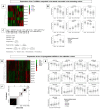Validation of a microRNA profile in urine liquid biopsy with diagnostic and stratification value for bladder cancer classification, available through the open app BladdermiRaCan
- PMID: 40217499
- PMCID: PMC11987439
- DOI: 10.1186/s40164-025-00649-0
Validation of a microRNA profile in urine liquid biopsy with diagnostic and stratification value for bladder cancer classification, available through the open app BladdermiRaCan
Abstract
We aimed to identify a profile of urine microRNAs (miRNAs) with diagnostic and stratification potential in the whole range of bladder cancer (BC) categories, to avoid current invasive, harmful and expensive procedures. We collected a first morning urine sample from the screening (35 BC patients and 15 age- and gender-matched controls) and validation cohorts (172 BC and 94 controls). In the screening stage we analyzed the expression level of 179 miRNAs by real-time reverse transcription quantitative PCR in urine supernatants. miRNA levels in each sample were normalized by the levels of the previously identified and stably expressed miR-29c-3p. We performed an ordinal regression for each miRNA with False Discovery Rate (FDR) adjustment to identify dysregulated miRNAs, and an ordinal elastic net logistic regression model to identify a miRNA profile for BC diagnosis and stratification with the software R (v3.5.1). Next, we validated the most dysregulated miRNAs, and empirically identified the real miRNA targets in BC cells by miR-eCLIP immunoprecipitation and sequencing. We identified 70 dysregulated miRNAs in BC patients (p < 0.05 FDR-adjusted). With the expression level of 7 miRNAs in urine (miR-221-3p, miR-93-5p, miR-362-3p, miR-191-5p, miR-200c-3p, miR-192-5p, miR-21-5p) we could stratify BC patients and control subjects. To enable the global use of our model, we developed the free BladdermiRaCan online tool. Furthermore, we identified miR-21-5p, miR-425-5p and miR-99a-5p as follow-up markers for BC relapse, and miR-21-5p and miR-221-3p as markers for metastasis. These miRNAs were also dysregulated in BC tissue sections from a subgroup of patients from which urine samples were studied. In conclusion, we have validated and patented a 7-miRNAs urine profile able to diagnose and stratify BC patients; BladdermiRaCan will enable the global use of our model. The experimentally verified target proteins identified for these miRNAs may unravel novel therapeutic targets.
Keywords: Biomarker; Bladder cancer; BladdermiRaCan; Diagnosis; Liquid biopsy; Prognosis; Stratification; Urine; miR-eCLIP Immunoprecipitation; microRNA.
© 2025. The Author(s).
Conflict of interest statement
Declarations. Ethics approval and consent to participate: All participants provided written informed consent according to protocols approved by the ethics review board at La Fe University and Polytechnic Hospital (Ref. 2014/0314). The study was performed according to the declaration of Helsinki, as amended in Edinburgh in 2000. Consent for publication: Not applicable. Competing interests: The authors declare no competing interests.
Figures

Similar articles
-
Identification of a three-miRNA panel in serum for bladder cancer diagnosis by a diagnostic test.Transl Cancer Res. 2022 May;11(5):1005-1016. doi: 10.21037/tcr-21-2611. Transl Cancer Res. 2022. PMID: 35706801 Free PMC article.
-
Testing the accuracy of a four serum microRNA panel for the detection of primary bladder cancer: a discovery and validation study.Biomarkers. 2024 Jul;29(5):276-284. doi: 10.1080/1354750X.2024.2358312. Epub 2024 May 30. Biomarkers. 2024. PMID: 38767408
-
Identification of miR-29c-3p as a Robust Normalizer for Urine microRNA Studies in Bladder Cancer.Biomedicines. 2020 Oct 22;8(11):447. doi: 10.3390/biomedicines8110447. Biomedicines. 2020. PMID: 33105660 Free PMC article.
-
Expanding frontiers in liquid biopsy-discovery and validation of circulating biomarkers in renal cell carcinoma and bladder cancer.Int Rev Cell Mol Biol. 2025;391:135-197. doi: 10.1016/bs.ircmb.2024.08.005. Epub 2024 Sep 12. Int Rev Cell Mol Biol. 2025. PMID: 39939075 Review.
-
An Evaluation of Serum miRNA in Renal Cell Carcinoma: A Systematic Review.Cancers (Basel). 2025 Feb 26;17(5):816. doi: 10.3390/cancers17050816. Cancers (Basel). 2025. PMID: 40075664 Free PMC article. Review.
Cited by
-
The emerging role of miR-362 in cancer: expression and function across different cancer types.Med Oncol. 2025 Jul 26;42(9):380. doi: 10.1007/s12032-025-02900-4. Med Oncol. 2025. PMID: 40715910 Review.
References
-
- Sung H, Ferlay J, Siegel RL, Laversanne M, Soerjomataram I, Jemal A, et al. Global cancer statistics 2020: GLOBOCAN estimates of incidence and mortality worldwide for 36 cancers in 185 countries. CA Cancer J Clin. 2021;71:209–49. - PubMed
-
- Svatek RS, Hollenbeck BK, Holmäng S, Lee R, Kim SP, Stenzl A, et al. The economics of bladder cancer: costs and considerations of caring for this disease. Eur Urol. 2014;66:253–62. - PubMed
Publication types
Grants and funding
LinkOut - more resources
Full Text Sources

